Estimate Forest Aboveground Biomass of Mountain by ICESat-2/ATLAS Data Interacting Cokriging
Abstract
1. Introduction
2. Materials and Methods
2.1. Study Area
2.2. ATLAS Data Products
2.3. Sample Plots Design
2.4. Determine the Scope of Woodland
2.5. Digital Elevation Model
2.6. Research Methods
2.6.1. ICESat-2/ATLAS Data Processing Methods
- (1)
- Photon point cloud denoising algorithmA comprehensive denoising algorithm consisting of the density difference-based spatial clustering noise algorithm (DDBSCAN) [39] and the K-nearest-neighbor-based denoising algorithm (KNNB) [40] was used to remove noisy photons. Zhang et al. [41] used the maximum density difference in the DDBSCAN algorithm as the final metric in the DDBSCAN algorithm in order to compensate for the effect of photon density inconsistency on the performance of the localized statistics-based algorithm.
- (2)
- Photon classification algorithm
2.6.2. Optimized RF Algorithm
2.6.3. Geostatistical Methods
- (1)
- Semivariance function
- (2)
- Cokriging (COK) is a linear unbiased optimal estimation method that uses readily available variables in conjunction with hard-to-obtain variables. The formula is as follows:where is the estimated AGB at the point to be estimated; , are the weights of the measured values of the primary variable and the secondary variable ; m is the number of measured values of the secondary variable .
2.7. Evaluation of Model Accuracy
3. Results
3.1. Correlation Analysis of Model Variables
3.2. AGB Model Construction Based on Optimized RF
3.3. AGB Estimation Results within ATLAS Footprints
3.4. Statistical Analysis of Interpolated Variables and Determination of Variance Functions
3.5. Validation of Interpolation Results
3.6. Spatial Distribution Analysis of AGB
4. Discussion
4.1. Validity Analysis of Estimation Results
4.2. Elimination of Error Transmission Feasibility Analysis
4.3. Analysis of the Interpolation Result String Phenomenon Is Obvious
5. Conclusions
Author Contributions
Funding
Data Availability Statement
Acknowledgments
Conflicts of Interest
References
- Meng, L. Distribution of Forest Biomass for Main Forest Types in the Forestry Administration of Daxinganling Based on Geostatistics. Master’s Thesis, Northeast Forestry University, Heilongjiang, China, 2017. (In Chinese). [Google Scholar]
- Tuominen, S.; Eerikäinen, K.; Schibalski, A.; Haakana, M.; Lehtonen, A. Mapping biomass variables with a multi-source forest inventory technique. Silva Fenn. 2010, 44, 109–119. [Google Scholar] [CrossRef]
- Kangas, A.; Maltamo, M. Forest Inventory: Methodology and Applications; Springer Science & Business Media: Cham, Switzerland, 2006; Volume 10. [Google Scholar] [CrossRef]
- López-Serrano, P.M.; López Sánchez, C.A.; Solís-Moreno, R.; Corral-Rivas, J.J. Geospatial estimation of above ground forest biomass in the Sierra Madre Occidental in the state of Durango, Mexico. Forests 2016, 7, 70. [Google Scholar] [CrossRef]
- Peduzzi, A.; Wynne, R.H.; Fox, T.R.; Nelson, R.F.; Thomas, V.A. Estimating leaf area index in intensively managed pine plantations using airborne laser scanner data. For. Ecol. Manag. 2012, 270, 54–65. [Google Scholar] [CrossRef]
- Atwood, D.K.; Andersen, H.E.; Matthiss, B.; Holecz, F. Impact of Topographic Correction on Estimation of Aboveground Boreal Biomass Using Multi-temporal, L-Band Backscatter. IEEE J. Sel. Top. Appl. Earth Obs. Remote Sens. 2014, 7, 3262–3273. [Google Scholar] [CrossRef]
- Vatandaşlar, C.; Abdikan, S. Carbon stock estimation by dual-polarized synthetic aperture radar (SAR) and forest inventory data in a Mediterranean forest landscape. J. For. Res. 2021, 33, 827–838. [Google Scholar] [CrossRef]
- Disney, M. Terrestrial LiDAR: A 3D revolution in how we look at trees. New Phytol. 2018, 222, 15517. [Google Scholar] [CrossRef]
- Pitkänen, T.P.; Raumonen, P.; Kangas, A. Measuring stem diameters with TLS in boreal forests by complementary fitting procedure. ISPRS J. Photogramm. Remote Sens. 2019, 147, 294–306. [Google Scholar] [CrossRef]
- Wang, Y.; Ni, W.; Sun, G.; Chi, H.; Zhang, Z.; Guo, Z. Slope-adaptive waveform metrics of large footprint lidar for estimation of forest aboveground biomass. Remote Sens. Environ. 2019, 224, 386–400. [Google Scholar] [CrossRef]
- Lefsky, M.A.; Harding, D.J.; Keller, M.; Cohen, W.B.; Carabajal, C.C.; Del Bom Espirito-Santo, F.; Hunter, M.O.; de Oliveira, R., Jr. Estimates of forest canopy height and aboveground biomass using ICESat. Geophys. Res. Lett. 2005, 32, L22S02. [Google Scholar] [CrossRef]
- Markus, T.; Neumann, T.; Martino, A.; Abdalati, W.; Brunt, K.; Csatho, B.; Farrell, S.; Fricker, H.; Gardner, A.; Harding, D. The Ice, Cloud, and land Elevation Satellite-2 (ICESat-2): Science requirements, concept, and implementation. Remote Sens. Environ. 2017, 190, 260–273. [Google Scholar] [CrossRef]
- Sawruk, N.; Burns, P.; Edwards, R.; Litvinovitch, V.; Hovis, F. Flight Lasers Transmitter Development for Nasa Ice Topography Icesat-2 Space Mission. In Proceedings of the IGARSS 2018—2018 IEEE International Geoscience and Remote Sensing Symposium, Valencia, Spain, 22–27 July 2018. [Google Scholar] [CrossRef]
- Hu, Y.; Wu, F.; Sun, Z.; Lister, A.; Gao, X.; Li, W.; Peng, D. The Laser Vegetation Detecting Sensor: A Full Waveform, Large-Footprint, Airborne Laser Altimeter for Monitoring Forest Resources. Sensors 2019, 19, 1699. [Google Scholar] [CrossRef]
- Moussavi, M.S.; Abdalati, W.; Scambos, T.; Neuenschwander, A. Applicability of an automatic surface detection approach to micro-pulse photon-counting lidar altimetry data: Implications for canopy height retrieval from future ICESat-2 data. Int. J. Remote Sens. 2014, 35, 5263–5279. [Google Scholar] [CrossRef]
- Brown, M.; Escobar, V. NASA’s Early Adopter Program Links Satellite Data to Decision Making. Remote Sens. 2019, 11, 406. [Google Scholar] [CrossRef]
- Wulder, M.A.; Bater, C.W.; Coops, N.C.; Hilker, T.; White, J.C. The role of LiDAR in sustainable forest management. For. Chron. 2008, 84, 807–826. [Google Scholar] [CrossRef]
- Yue, C.; Zhen, Y.; Xing, Y.; Pang, Y.; Li, S.; Cai, L.; He, H. Technical and application development study of space-borne LiDAR in forestry remote sensing. Infrared Laser Eng. 2020, 49, 105–114. [Google Scholar] [CrossRef]
- Narine, L.L.; Popescu, S.; Neuenschwander, A.; Zhou, T.; Srinivasan, S.; Harbeck, K. Estimating aboveground biomass and forest canopy cover with simulated ICESat-2 data. Remote Sens. Environ. 2019, 224, 37. [Google Scholar] [CrossRef]
- Narine, L.L.; Popescu, S.C.; Malambo, L. Synergy of ICESat-2 and Landsat for mapping forest aboveground biomass with deep learning. Remote Sens. 2019, 11, 1503. [Google Scholar] [CrossRef]
- Narine, L.L.; Popescu, S.C.; Malambo, L. Using ICESat-2 to estimate and map forest aboveground biomass: A first example. Remote Sens. 2020, 12, 1824. [Google Scholar] [CrossRef]
- Li, W.; Niu, Z.; Shang, R.; Qin, Y.; Wang, L.; Chen, H. High-resolution mapping of forest canopy height using machine learning by coupling ICESat-2 LiDAR with Sentinel-1, Sentinel-2 and Landsat-8 data. Int. J. Appl. Earth Obs. Geoinf. 2020, 92, 102163. [Google Scholar] [CrossRef]
- Silva, C.A.; Duncanson, L.; Hancock, S.; Neuenschwander, A.; Thomas, N.; Hofton, M.; Fatoyinbo, L.; Simard, M.; Marshak, C.Z.; Armston, J. Fusing simulated GEDI, ICESat-2 and NISAR data for regional aboveground biomass mapping. Remote Sens. Environ. 2021, 253, 112234. [Google Scholar] [CrossRef]
- Feng, Y. Spatial Statistics Theory and Its Application in Forestry; Chinese Forestry Publishing House: Beijing, China, 2008. (In Chinese) [Google Scholar]
- Wang, H.; Peng, D.; FAn, Y.; Li, W.; Zhang, C. Spatial Modeling of Forest Stock Volume Based onAuxiliary In-formation. Trans. Chin. Soc. Agric. Mach. 2016, 47, 7. (In Chinese) [Google Scholar]
- Hajj, M.E.; Baghdadi, N.; Fayad, I.; Vieilledent, G.; Bailly, J.-S.; Minh, D.H.T. Interest of integrating spaceborne LiDAR data to improve the estimation of biomass in high biomass forested areas. Remote Sens. 2017, 9, 213. [Google Scholar] [CrossRef]
- Tsui, O.W.; Coops, N.C.; Wulder, M.A.; Marshall, P.L. Integrating airborne LiDAR and space-borne radar via multivariate kriging to estimate above-ground biomass. Remote Sens. Environ. 2013, 139, 340–352. [Google Scholar] [CrossRef]
- Jin, Y.; Zhang, M.; Guo, H.; He, W. Comparison of Forest Carbon Spatial Distribution Based on Kriging In-terpolation and Sequential Gaussian Co-Simulation. J. Southwest For. Univ. 2013, 33, 32–37, 45. (In Chinese) [Google Scholar]
- He, P.; Zhang, H.; Lei, X.; Xu, G.; Gao, X. Estimation of forest Above-Ground Biomass based on geostatistics. Sci-Entia Silvae Sin. 2013, 49, 101–109. (In Chinese) [Google Scholar]
- Xu, D.; Zhang, J.; Bao, R.; Liao, Y.; Han, D.; Liu, Q.; Cheng, T. Temporal and Spatial Variation of Aboveground Biomass of Pinus densata and Its Drivers in Shangri-La, CHINA. Int. J. Environ. Res. Public Health 2022, 19, 400. [Google Scholar] [CrossRef]
- Feng, W.; Wang, L.; Xie, J.; Yue, C.; Zheng, Y.; Yu, L. Estimation of Forest Biomass Based on Muliti-Source Remote Sensing Data Set-a Case Study of Shangri-La County. ISPRS Ann. Photogramm. Remote Sens. Spat. Inf. Sci. 2018, IV-3, 77–81. [Google Scholar] [CrossRef]
- Neuenschwander, A.; Pitts, K. The ATL08 land and vegetation product for the ICESat-2 Mission. Remote Sens. Environ. 2019, 221, 247–259. [Google Scholar] [CrossRef]
- Brown, M.E.; Arias, S.D.; Neumann, T.; Jasinski, M.F.; Posey, P.; Babonis, G.; Glenn, N.F.; Birkett, C.M.; Escobar, V.M.; Markus, T. Applications for ICESat-2 Data: From NASA’s Early Adopter Program. IEEE Geosci. Remote Sens. Mag. 2016, 4, 24–37. [Google Scholar] [CrossRef]
- Neuenschwander, A.L.; Magruder, L.A. Canopy and Terrain Height Retrievals with ICESat-2: A First Look. Remote Sens. 2019, 11, 1721. [Google Scholar] [CrossRef]
- Neumann, T.; Brenner, A.; Hancock, D.; Robbins, J.; Saba, J.; Harbeck, K.; Gibbons, A. Ice, Cloud, and Land Elevation Satellite–2 (Icesat-2) Project: Algorithm Theoretical Basis Document (ATBD) for Global Geolocated Photons (ATL03); Goddard Space Flight Center: Greenbelt, MD, USA, 2019.
- Wang, J.; Tang, W. Estimation and analysis of aboveground biomass and carbon storage of arbor forest based on forest resource planning and design survey data: A case study of Shangri-La City. J. Green Sci. Technol. 2021, 23, 14–16. (In Chinese) [Google Scholar]
- Yuan, L. Natural forest biomass of Pinus armandii plantation in Yunlong Tianchi Nature Reserve of Yunnan Province. Prot. For. Sci. Technol. 2018, 38, 13–15. (In Chinese) [Google Scholar]
- Zeng, W.; Sun, X.; Wang, L.; Wang, W.; Pu, Y. Developing stand volume, biomass and carbon stock models for ten major forest types in forest region of northeastern China. J. Beijing For. Univ. 2021, 43, 1–8. (In Chinese) [Google Scholar]
- Zhang, J.; Kerekes, J. An adaptive density-based model for extracting surface returns from photon-counting laser altimeter data. IEEE Geosci. Remote Sens. Lett. 2014, 12, 726–730. [Google Scholar] [CrossRef]
- Xia, S.B.; Wang, C.; Xi, X.H.; Luo, S.Z.; Zeng, H.C. Point cloud filtering and tree height estimation using airborne experiment data of ICESat-2. J. Remote Sens 2014, 18, 1199–1207. [Google Scholar]
- Zhang, J.; Tian, J.; Li, X.; Wang, L.; Chen, B.; Gong, H.; Ni, R.; Zhou, B.; Yang, C. Leaf area index retrieval with ICESat-2 photon counting LiDAR. Int. J. Appl. Earth Obs. Geoinf. 2021, 103, 102488. [Google Scholar] [CrossRef]
- Nie, S.; Wang, C.; Dong, P.; Xi, X.; Luo, S.; Qin, H. A revised progressive TIN densification for filtering airborne LiDAR data. Measurement 2017, 104, 70–77. [Google Scholar] [CrossRef]
- Breiman, L.; Breiman, L.; Cutler, R.A. Random Forests Machine Learning. J. Clin. Microbiol. 2001, 2, 199–228. [Google Scholar]
- Luo, G. A review of automatic selection methods for machine learning algorithms and hyper-parameter values. Netw. Model. Anal. Health Inform. Bioinform. 2016, 5, 18. [Google Scholar] [CrossRef]
- Bergstra, J.; Bengio, Y. Random search for hyper-parameter optimization. J. Mach. Learn. Res. 2012, 13, 281–305. [Google Scholar]
- Geurts, P.; Ernst, D.; Wehenkel, L. Extremely randomized trees. Mach. Learn. 2006, 63, 3–42. [Google Scholar] [CrossRef]
- Yu, H.; Ni, J.; Xu, S. Pre-evaluation strategy of harmfulness caused by class imbalance based on Leave-one-out Cross Validation. J. Chin. Comput. Syst. 2012, 33, 2287–2292. (In Chinese) [Google Scholar]
- Xie, F.; Shu, Q. Estimation and Mapping of Forest Aboveground Biomass Based on k-NN Model and Remote Sensing. Master’s Thesis, Southwest Forestry University, Kunming, China, 2019. (In Chinese). [Google Scholar]
- Zhen, X.; Lu, L. Geostatistics (Modern Spatial Statistics); Science Press: Beijing, China, 2018. (In Chinese) [Google Scholar]
- Song, H.; Shu, Q.; Xi, L.; Qiu, S.; Wei, Z.; Yang, Z. Remote sensing estimation of forest above-ground biomass based on spaceborne lidar ICESat-2/ATLAS data. Trans. Chin. Soc. Agric. Eng. 2022, 38, 191–199. (In Chinese) [Google Scholar]
- SUn, L.; Chang, Q.; Zhao, Y.; Zhang, Y. Spatial distribution of soil nutrients in hilly region of Southern Shaanxi. J. Northwest AF Univ. 2015, 43, 162–168, 174. (In Chinese) [Google Scholar]
- Yue, C. Forest Biomass Estimation in Shangri-La County based on Remote Sensing. Ph.D. Thesis, Beijing Forestry University, Beijing, China, 2012. (In Chinese). [Google Scholar]
- Wang, J.; Chen, P.; Xu, S.; Wang, X.; Chen, F. Forest Biomass Estimation in Shangri-La based on the Remote Sensing. J. Zhejiang A F Univ. 2013, 30, 325–329. (In Chinese) [Google Scholar]
- Hatcher, W.G.; Yu, W. A survey of deep learning: Platforms, applications and emerging research trends. IEEE Access 2018, 6, 24411–24432. [Google Scholar] [CrossRef]
- Victoria, A.H.; Maragatham, G. Automatic tuning of hyperparameters using Bayesian optimization. Evol. Syst. 2021, 12, 217–223. [Google Scholar] [CrossRef]
- Moradi, F.; Sadeghi, S.M.M.; Heidarlou, H.B.; Deljouei, A.; Boshkar, E.; Borz, S.A. Above-ground biomass estimation in a Mediterranean sparse coppice oak forest using Sentinel-2 data. Ann. For. Res. 2022, 65, 165–182. [Google Scholar] [CrossRef]
- Moradi, F.; Darvishsefat, A.A.; Pourrahmati, M.R.; Deljouei, A.; Borz, S.A. Estimating Aboveground Biomass in Dense Hyrcanian Forests by the Use of Sentinel-2 Data. Forests 2022, 13, 104. [Google Scholar] [CrossRef]
- Zhang, J.; Fu, W.; Du, Q.; Zhang, G.; Jiang, P. Effects of topographical condition and sampling number on the interpolation precision of forest litter carbon density. Chin. J. Appl. Ecol. 2013, 24, 2241–2247. (In Chinese) [Google Scholar]
- Liu, X.; Su, Y.; Hu, T.; Yang, Q.; Liu, B.; Deng, Y.; Tang, H.; Tang, Z.; Fang, J.; Guo, Q. Neural network guided interpolation for mapping canopy height of China’s forests by integrating GEDI and ICESat-2 data. Remote Sens. Environ. 2022, 269, 112844. [Google Scholar] [CrossRef]
- Liu, L.; Wang, H.; Dai, W.; Yang, X.; Li, X. Spatial heterogeneity of soil organic carbon and nutrients in low mountain area of Changbai Mountains. Chin. J. Appl. Ecol. 2014, 25, 2460–2468. (In Chinese) [Google Scholar]
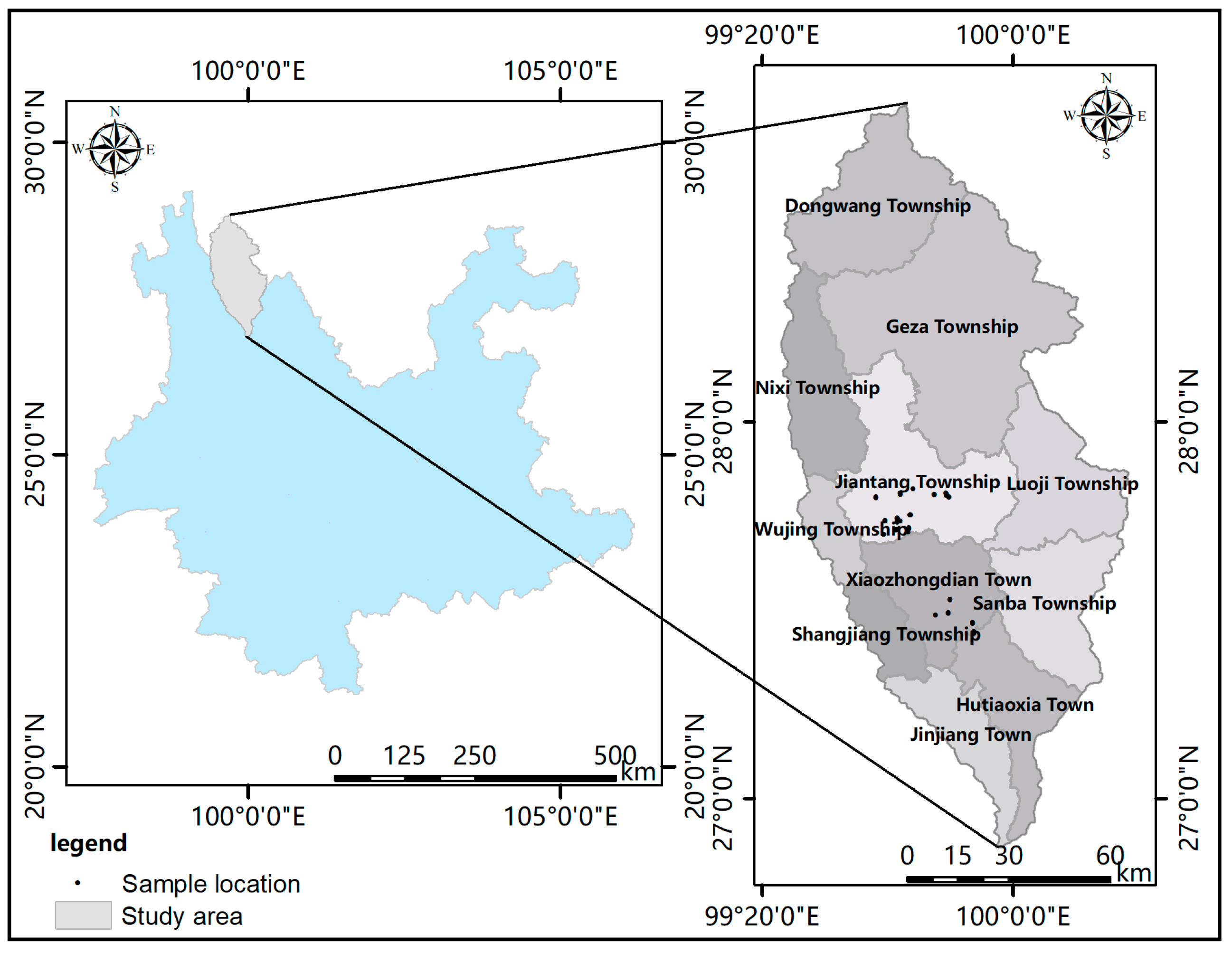

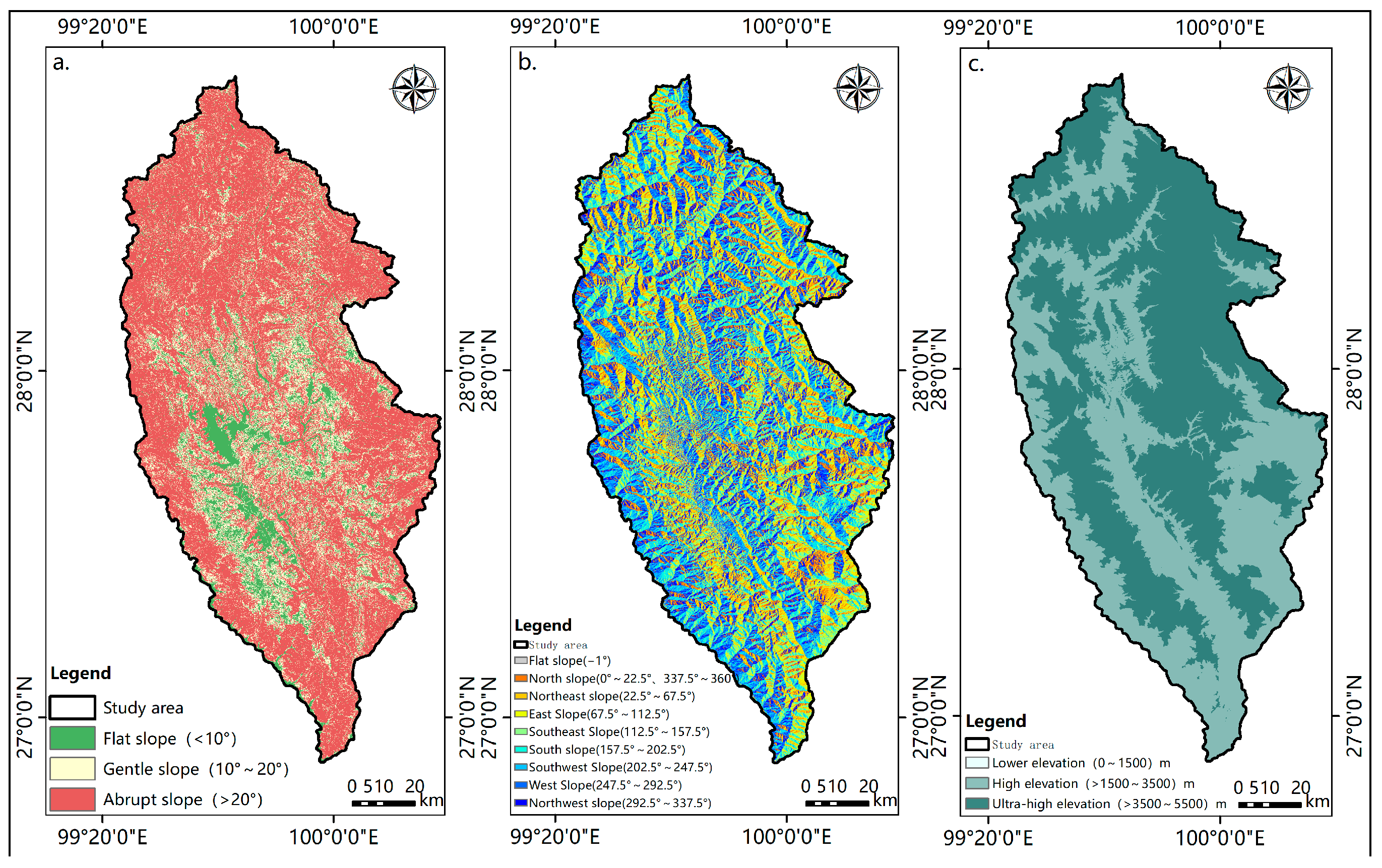
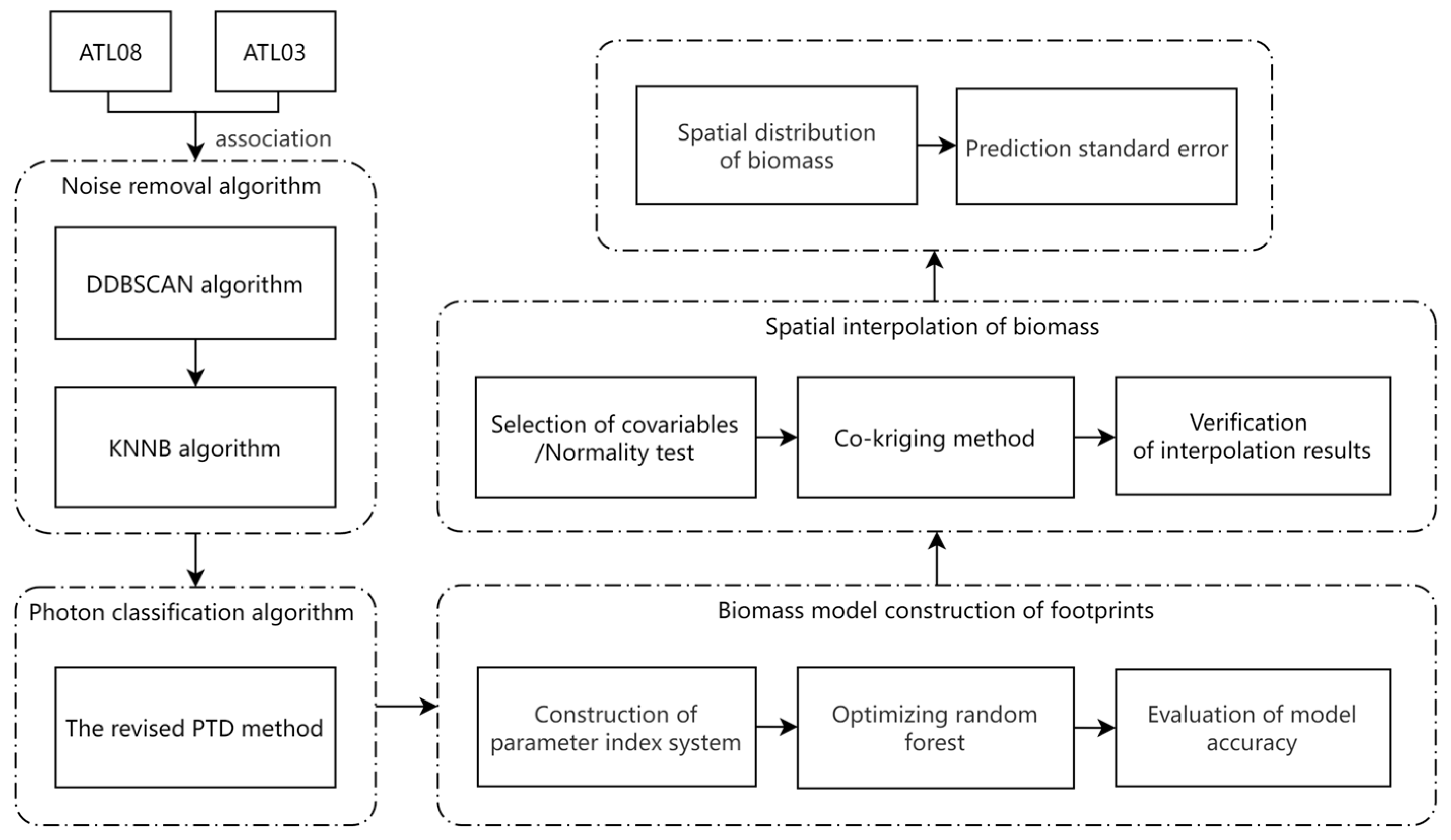

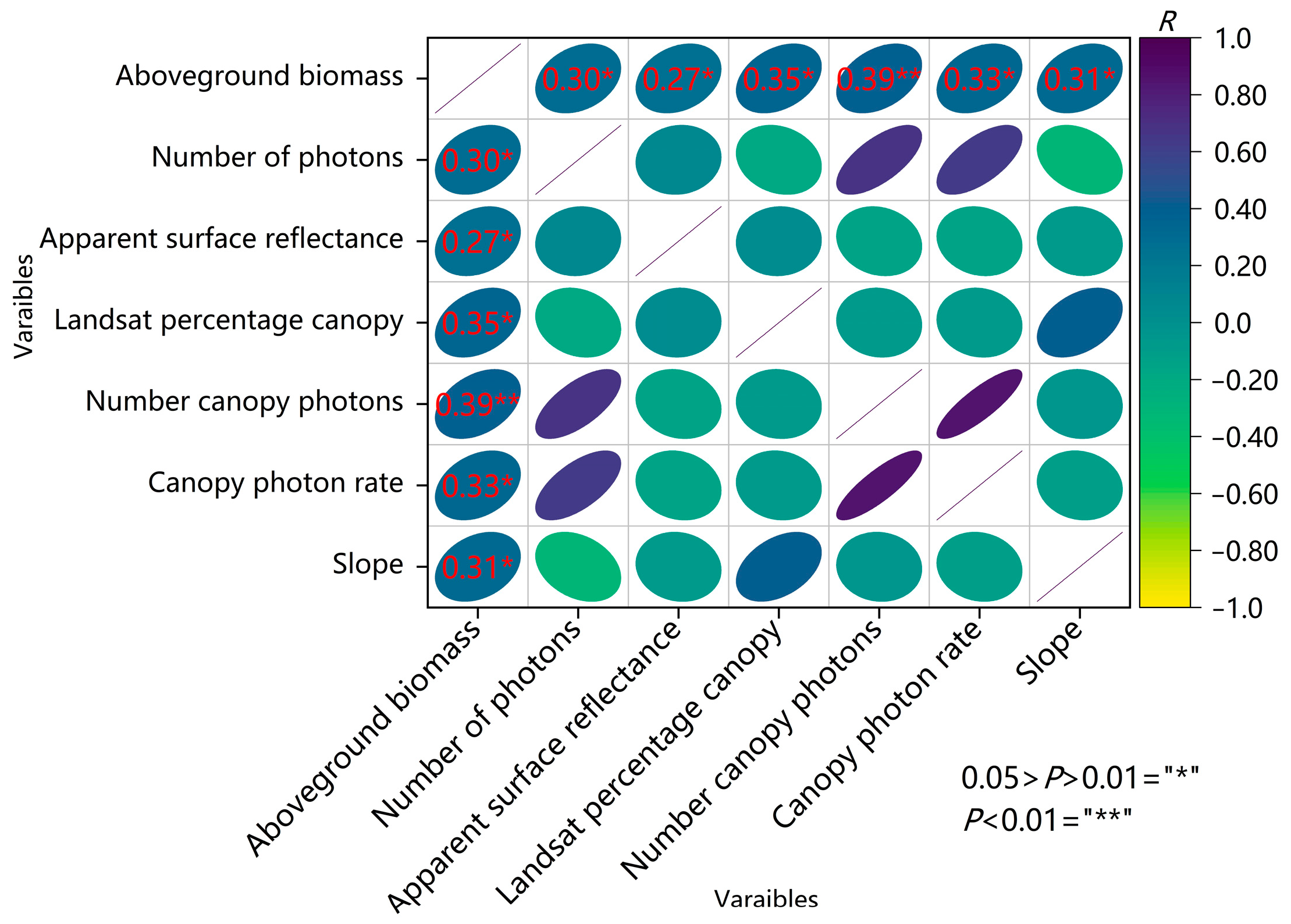

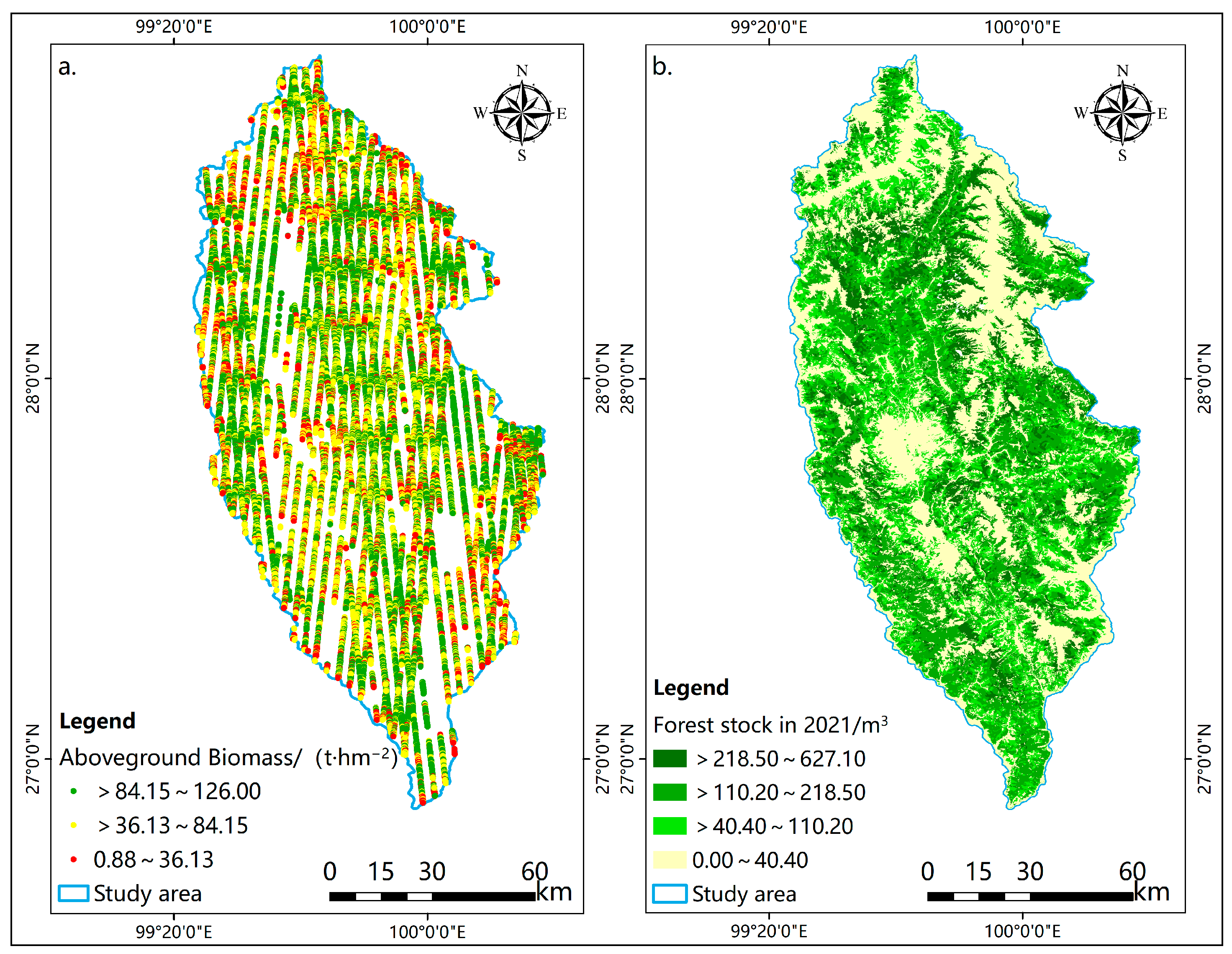
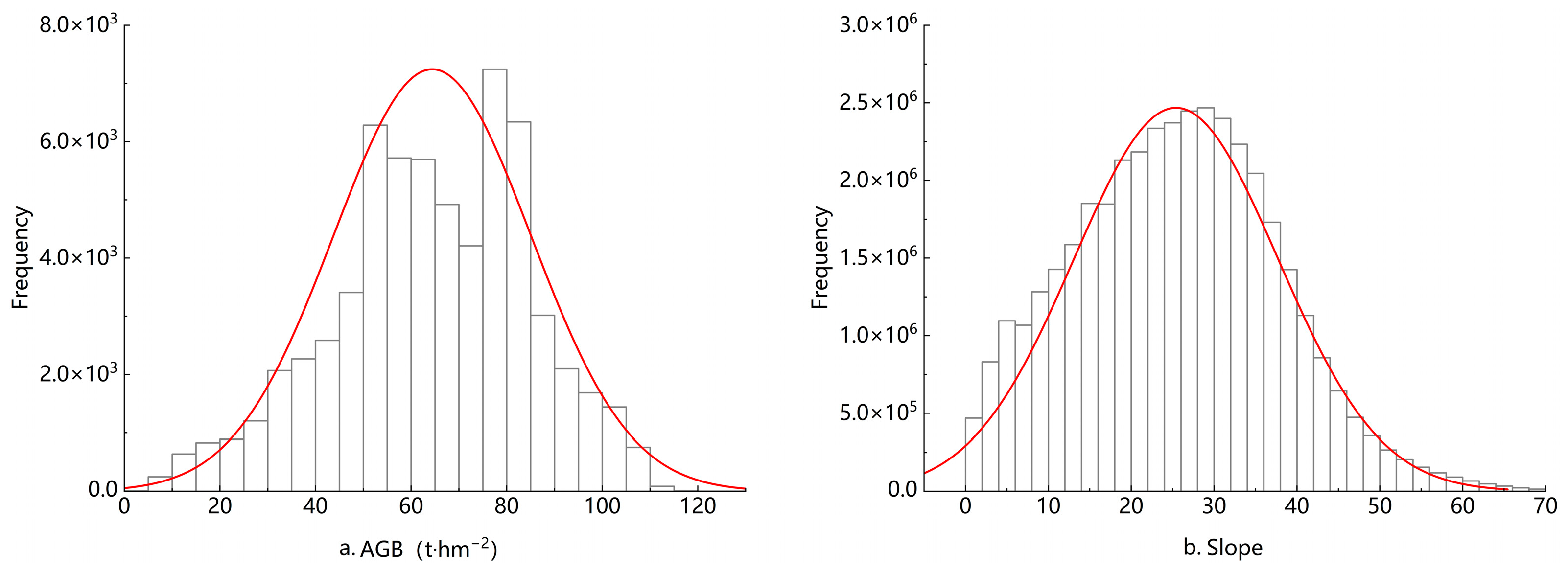
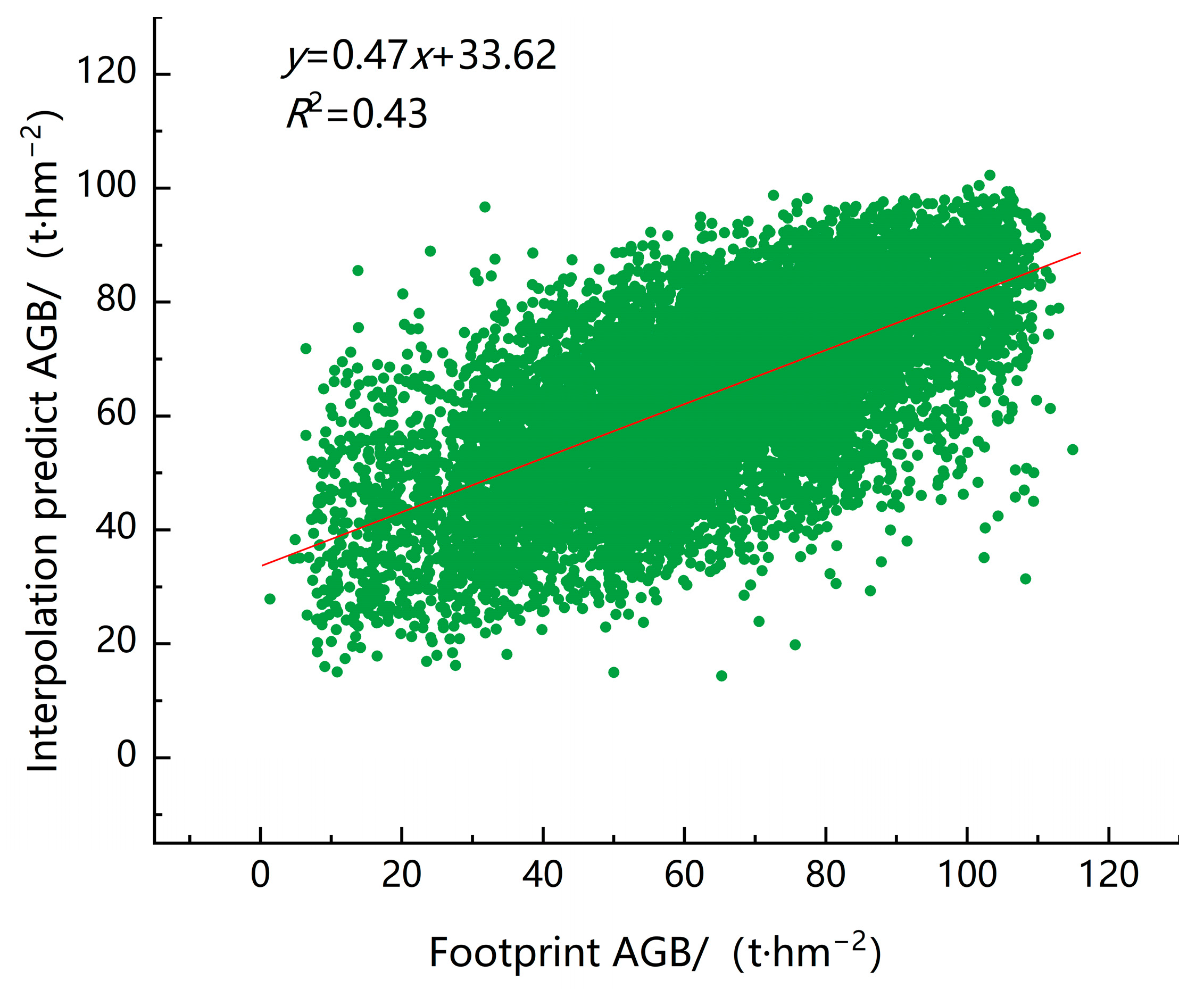
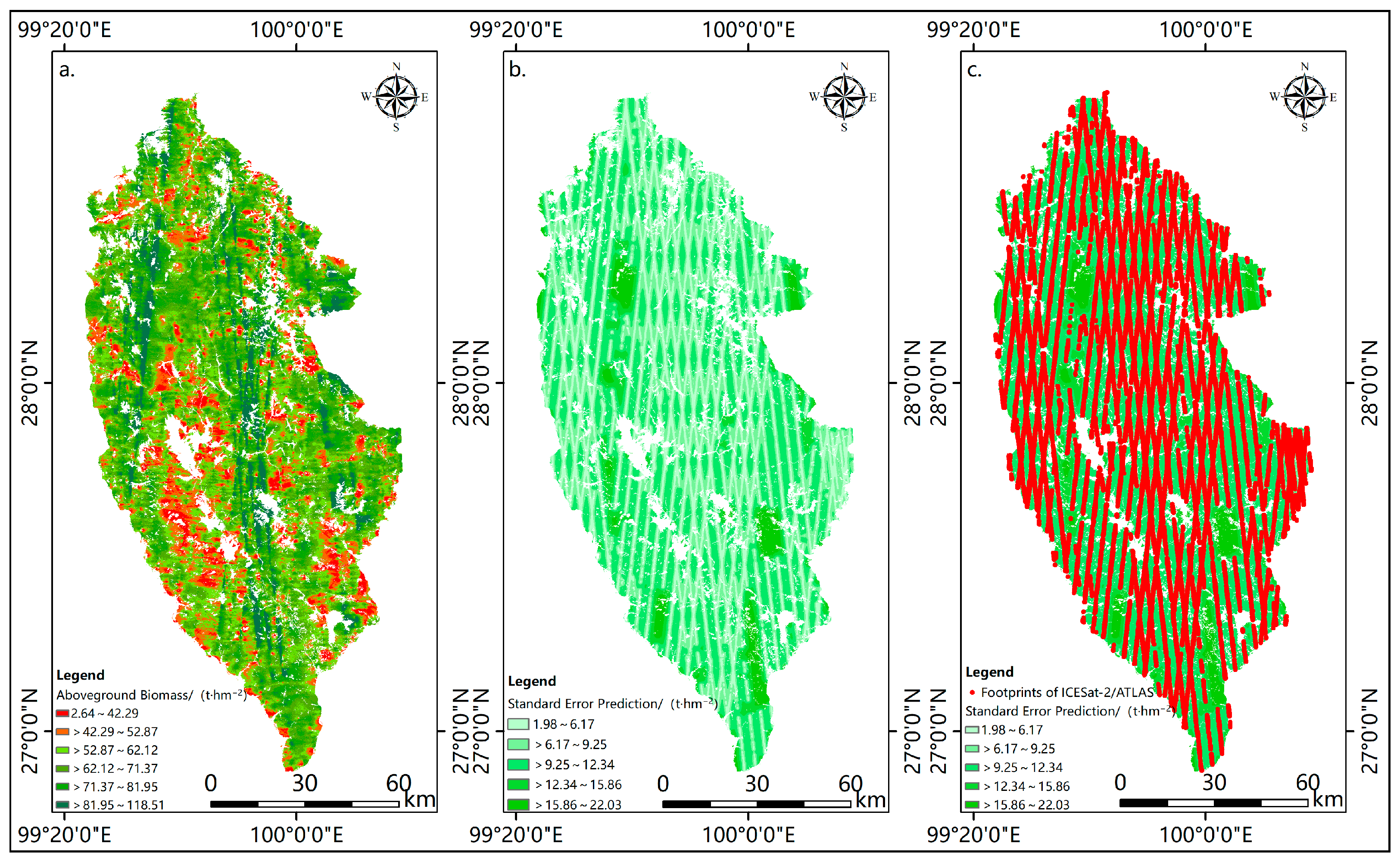
| Tree Species | Diameter at Breast Height | Aboveground Biomass Model |
|---|---|---|
| Abies fabri | D ≥ 5 | MA = 0.06127D2.05753H0.50839 [36] |
| D < 5 | MA = 0.19406D1.34122H0.50839 [36] | |
| Quercus | D ≥ 5 | MA = 0.07806D2.06321H0.57393 [36] |
| D < 5 | MA = 0.22999D1.39183H0.57393 [36] | |
| Pinus densata | D > 0 | MA = 0.0730D2.3560H0.1090 [36] |
| Picea asperata | D ≥ 5 | MA = 0.09152D2.2106H0.25663 [36] |
| D < 5 | MA = 0.16923D1.82866H0.25663 [36] | |
| Pinus yunnanensis | D > 0 | MA = 0.070231D2.10392H0.41120 [36] |
| Larix gmelinii | D ≥ 5 | MA = 0.05577D2.01549H0.59146 [36] |
| D < 5 | MA = 0.15678D1.37332H0.59146 [36] | |
| Pinus armandii | D > 0 | MA = 0.009512(D2H)1.138665 [37] |
| Populus | D > 0 | MB = 2.83252G0.000 00−0.46615M [38] |
| M = 1.37840G1.086410.57336 [38] |
| Numbers | Mean | Mean Standard Error | Standard Deviation | Max | Min |
|---|---|---|---|---|---|
| 54 | 59.48 | 5.29 | 37.45 | 126.00 | 0.88 |
| Parameters | Description [43,46] | Type |
|---|---|---|
| n_estimators | The number of trees in the forest. | int |
| min_samples_split | The minimum number of samples required to split an internal node. | int or float |
| min_samples_leaf | The minimum number of samples required to be at a leaf node. | int or float |
| max_features | The number of features to consider when looking for the best split. | int or float |
| max_depth | The maximum depth of the tree. | int |
| bootstrap | Whether bootstrap samples are used when building trees. | bool |
| Serial Number | Parameter | Long Name | Description |
|---|---|---|---|
| 1 | n_seg_ph | Number of photons | Number of photons within each land segment. |
| 2 | asr | Apparent surface reflectance | Apparent surface reflectance. |
| 3 | landsat_perc | Landsat percentage canopy | Average percentage value of the valid (value ≤ 100) Landsat Tree Cover Continuous Fields product for each 100 m segment. |
| 4 | n_ca_photons | Number canopy photons | The number of photons classified as canopy within the segment. |
| 5 | photon_rate_can | Canopy photon rate | Calculated photon rate of canopy photons within each 100 m segment. |
| 6 | Slope | Slope | Calculated based on DEM. |
| Variables | Mean | Standard Deviation | Max | Min |
|---|---|---|---|---|
| AGB/(t·hm−2) | 64.32 | 20.71 | 126.00 | 0.88 |
| Slope (°) | 25.40 | 12.30 | 82.53 | 0.00 |
| Model | Variable | Nugget | Sill | SR (%) | Range (%) | R2 | RSS |
|---|---|---|---|---|---|---|---|
| Spherical | Main variable | 0.01 | 0.22 | 94.0 | 6700.00 | 0.65 | 2.65 × 10−4 |
| Covariate | 0.10 | 125.90 | 99.9 | 8300.00 | |||
| Exponential | Main variable | 0.03 | 0.22 | 87.9 | 6600.00 | 0.64 | 2.76 × 10−4 |
| Covariate | 94.20 | 188.50 | 50.0 | 404,400.00 | |||
| Gaussian | Main variable | 0.04 | 0.22 | 82.1 | 5715.77 | 0.65 | 2.65 × 10−4 |
| Covariate | 0.10 | 126.00 | 99.9 | 6928.20 |
Disclaimer/Publisher’s Note: The statements, opinions and data contained in all publications are solely those of the individual author(s) and contributor(s) and not of MDPI and/or the editor(s). MDPI and/or the editor(s) disclaim responsibility for any injury to people or property resulting from any ideas, methods, instructions or products referred to in the content. |
© 2022 by the authors. Licensee MDPI, Basel, Switzerland. This article is an open access article distributed under the terms and conditions of the Creative Commons Attribution (CC BY) license (https://creativecommons.org/licenses/by/4.0/).
Share and Cite
Song, H.; Xi, L.; Shu, Q.; Wei, Z.; Qiu, S. Estimate Forest Aboveground Biomass of Mountain by ICESat-2/ATLAS Data Interacting Cokriging. Forests 2023, 14, 13. https://doi.org/10.3390/f14010013
Song H, Xi L, Shu Q, Wei Z, Qiu S. Estimate Forest Aboveground Biomass of Mountain by ICESat-2/ATLAS Data Interacting Cokriging. Forests. 2023; 14(1):13. https://doi.org/10.3390/f14010013
Chicago/Turabian StyleSong, Hanyue, Lei Xi, Qingtai Shu, Zhiyue Wei, and Shuang Qiu. 2023. "Estimate Forest Aboveground Biomass of Mountain by ICESat-2/ATLAS Data Interacting Cokriging" Forests 14, no. 1: 13. https://doi.org/10.3390/f14010013
APA StyleSong, H., Xi, L., Shu, Q., Wei, Z., & Qiu, S. (2023). Estimate Forest Aboveground Biomass of Mountain by ICESat-2/ATLAS Data Interacting Cokriging. Forests, 14(1), 13. https://doi.org/10.3390/f14010013






